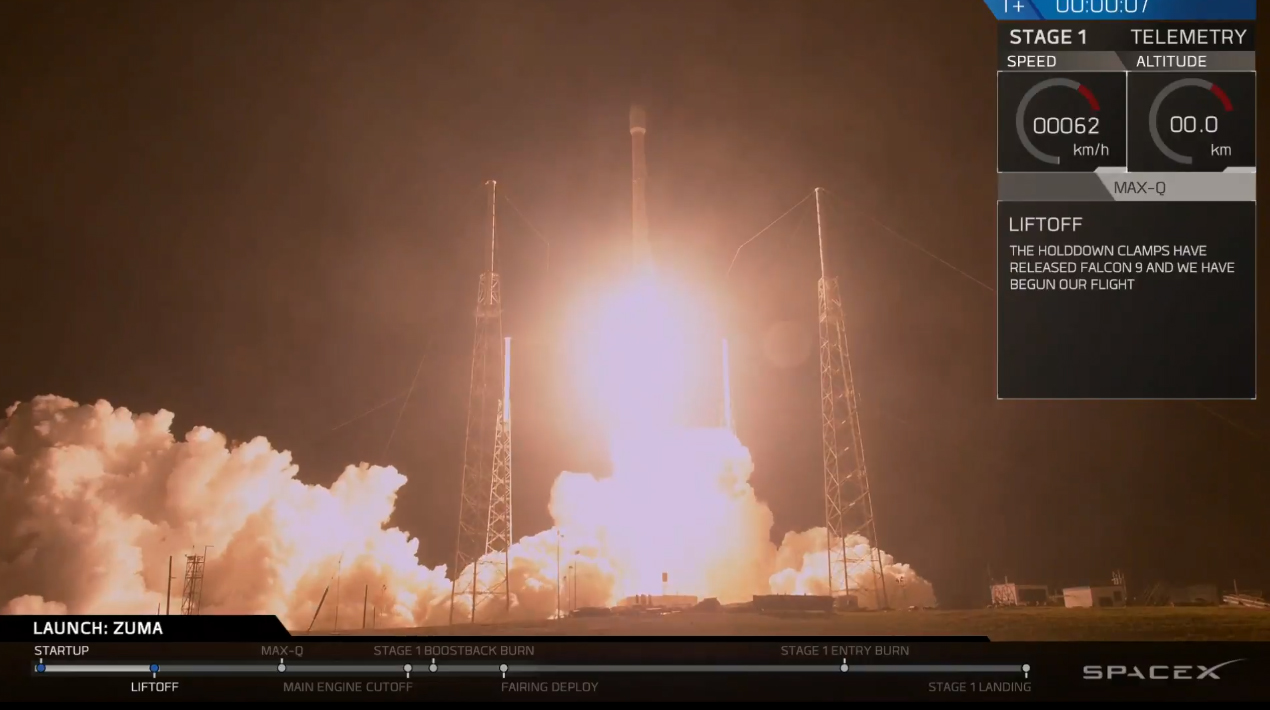SpaceX lofted the super-secret Zuma spacecraft for the U.S. government tonight (Jan. 7), successfully executing a mission that also featured yet another landing by the first stage of the company's Falcon 9 rocket.
The Falcon 9 lifted off at 8 p.m. EST (0100 GMT on Jan. 8) from Cape Canaveral Air Force Station, on Florida's Space Coast.
The booster's two stages separated 2 minutes and 19 seconds into flight. The second stage continued carrying the mysterious Zuma to its destination in low-Earth orbit (LEO), while the first stage began maneuvering its way back to terra firma for a touchdown at Landing Zone 1, a SpaceX facility at Cape Canaveral. [How SpaceX Lands Falcon 9 Rockets]
The first stage aced that landing, a little less than 8 minutes after taking off.

SpaceX now has 21 successful first-stage touchdowns under its belt, nine of them at Landing Zone 1 and the other 12 on "autonomous spaceport droneships" stationed in the ocean. (SpaceX has two of these uncrewed vessels, which are named "Just Read the Instructions" and "Of Course I Still Love You.")
These landings are part of SpaceX's effort to develop fully reusable rockets and spacecraft — technology that company founder and CEO Elon Musk has said will slash the cost of spaceflight. To date, SpaceX has re-flown five of these landed boosters, as well as two of its uncrewed Dragon cargo capsules, which make resupply runs to the International Space Station. (The Falcon 9 that lifted off tonight was brand-new.)
But the main goal of tonight's flight was getting Zuma aloft, so the spacecraft can start going about its business. Just what that business may be is unclear; little has been revealed about the payload.
Get the Space.com Newsletter
Breaking space news, the latest updates on rocket launches, skywatching events and more!
We do know that aerospace and defense company Northrop Grumman procured Zuma's launch atop a Falcon 9 for the U.S. government — but we don't know which agency will operate the satellite, or if its mission is civilian or military.
Northrop Grumman did reveal that Zuma is going to LEO, but that information doesn't tell us much; this range of altitudes houses a variety of spacecraft, from reconnaissance, weather and communications satellites to the International Space Station. And we don't know what Zuma's exact orbit is (though it's a safe bet that amateur satellite trackers will be working hard over the coming days and weeks to figure that out).
If Zuma is a national-security mission, it wouldn't be the first one that SpaceX has launched. Falcon 9s also launched a satellite for the National Reconnaissance Office in May 2017 and the Air Force's robotic X-37B space plane this past September.
The Zuma mission was originally supposed to launch in mid-November, but SpaceX stood down for a while to study data from payload-fairing test performed for another customer. (The payload fairing is the protective nose cone that encases a spacecraft during launch.)
Editor's note: This story was updated to correct the date for SpaceX's Zuma launch. It lifted off on Sunday, Jan. 7, not Jan. 8.
Follow Mike Wall on Twitter @michaeldwall and Google+. Follow us @Spacedotcom, Facebook or Google+. Originally published on Space.com.
Join our Space Forums to keep talking space on the latest missions, night sky and more! And if you have a news tip, correction or comment, let us know at: community@space.com.

Michael Wall is a Senior Space Writer with Space.com and joined the team in 2010. He primarily covers exoplanets, spaceflight and military space, but has been known to dabble in the space art beat. His book about the search for alien life, "Out There," was published on Nov. 13, 2018. Before becoming a science writer, Michael worked as a herpetologist and wildlife biologist. He has a Ph.D. in evolutionary biology from the University of Sydney, Australia, a bachelor's degree from the University of Arizona, and a graduate certificate in science writing from the University of California, Santa Cruz. To find out what his latest project is, you can follow Michael on Twitter.









